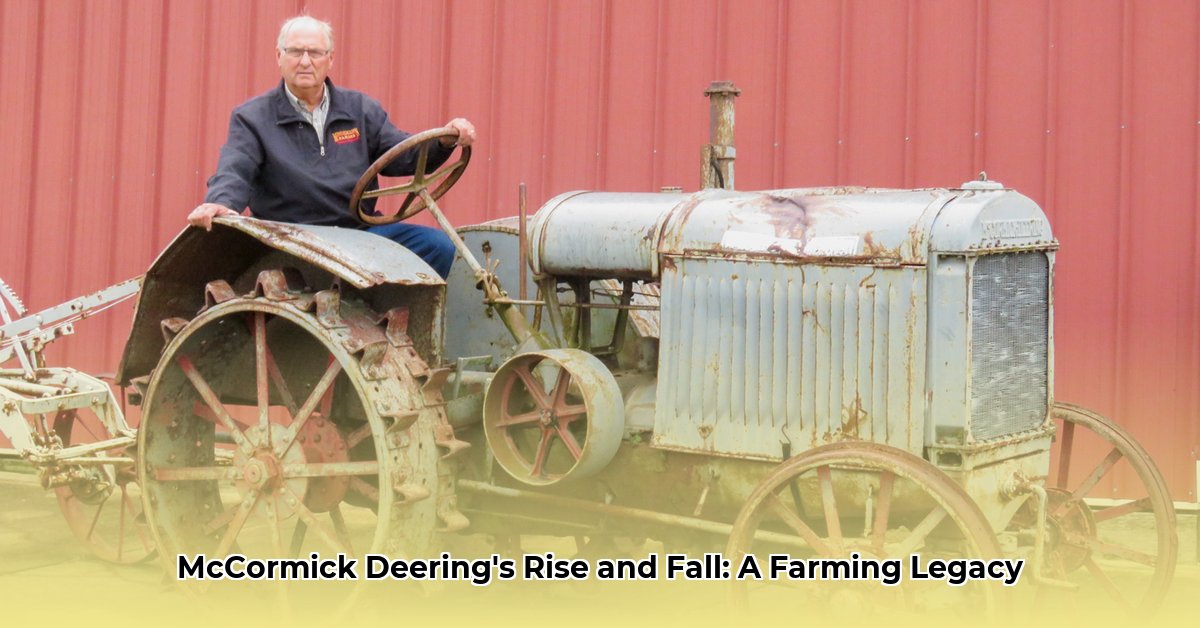
McCormick Deering Tractors: A Legacy Forged in Steel and Strategy
The rumble of a classic McCormick-Deering tractor evokes more than just nostalgia; it echoes a significant chapter in American agricultural history. This isn't simply a tale of rusty relics, but a compelling narrative of strategic business moves, groundbreaking innovation, and the inevitable challenges of maintaining dominance in a dynamic market. The story of McCormick-Deering offers surprisingly relevant lessons for modern agricultural businesses navigating today's complex landscape. For more on valuing classic farm equipment, check out this helpful tractor value guide.
The Birth of a Farm Equipment Giant: A Merger Makes History
Our journey begins in 1902, not with a lone inventor, but with a strategic merger: several competing companies, each possessing unique expertise in harvesting equipment, consolidated to form International Harvester (IHC). This union—a "supergroup" of farm machinery makers—created a powerhouse, and the McCormick Deering brand emerged as its flagship. The name itself was a brilliant strategic choice, leveraging established reputations for quality and reliability. This newly formed giant instantaneously commanded a substantial share of the farm equipment market, setting the standard for quality and efficiency from its inception. How did this audacious move shape the destiny of McCormick Deering and, ultimately, the face of American agriculture?
The roaring twenties and the subsequent decade witnessed McCormick-Deering's golden age. Their tractors became ubiquitous in American fields, celebrated for their strength, reliability, and innovative design. This wasn't simply good fortune; it was a testament to shrewd planning and an unwavering commitment to excellence. But could this success be sustained in the face of evolving market conditions?
Innovation: The Engine of Success
McCormick-Deering understood that innovation was paramount for maintaining a competitive edge. They continuously introduced improved tractor models, each reflecting advancements in agricultural technology and catering to the evolving needs of farmers. They weren't just building tractors; they were establishing a reputation for enhanced efficiency and productivity, fostering farmer loyalty and driving increased crop yields. This relentless pursuit of innovation solidified their position as market leaders. However, could this relentless pace of innovation be maintained indefinitely?
The Challenges of Staying on Top: Growing Pains and Shifting Sands
Even empires face challenges. The post-war era introduced heightened competition, with companies like John Deere emerging as formidable rivals. Compounding these external pressures, IHC embarked on a diversification strategy, venturing beyond farm equipment. While diversification might seem appealing—spreading risk and creating new revenue streams—in IHC's case, it arguably weakened their core business. Expert analysis suggests this strategic shift diluted their focus and ultimately hindered their dominance in the farm machinery sector, a cautionary tale for any company that strays too far from its core competency. What specific elements contributed to this strategic misstep?
The End of an Era, but Not the Legacy
By the late 1940s and early 1950s, the McCormick Deering name gradually faded as IHC transitioned to the International brand. It wasn't a sudden collapse but a phased evolution in response to a shifting agricultural landscape. The sale of IHC's farm equipment division in 1984 officially marked the end of this iconic brand. Yet, McCormick-Deering's impact on farming practices and technologies remains significant, a legacy of innovation, reliability, and an unwavering pursuit of agricultural progress. What lessons can we extract from this enduring legacy?
How Did McCormick-Deering's Diversification Strategy Impact Its Long-Term Sustainability?
The McCormick-Deering narrative serves as a captivating case study on the complexities of diversification. Did their expansion beyond farm machinery enhance their longevity, or did it sow the seeds of their decline?
McCormick-Deering's Early Success: A Foundation in Innovation
McCormick Harvesting Machine Company, later McCormick-Deering, initially dominated the reaper market. Their innovative reapers revolutionized agriculture, creating a powerful brand identity built on a legacy of innovation. But maintaining this dominance demanded more than merely perfecting the reaper itself. The agricultural landscape was undergoing a transformation.
The Diversification Drive: Expanding Horizons
McCormick-Deering's expansion into diverse farm machinery, including tractors and various implements, seemed strategically sound at the time. This diversification broadened their revenue streams, seemingly boosting resilience. However, the question remains: Did this diversification strategy ultimately hinder their long-term sustainability?
The Birth of International Harvester: A Giant's Emergence
The merger that formed International Harvester (IH) seemed to create an unstoppable force. Their broad product range—tractors, trucks, farm equipment, even construction equipment—spread their risk, right? But did this massive scale become a vulnerability?
The Challenges of Scale and Specialization: A Diversification Dilemma
The sheer breadth of IH's portfolio became a source of its eventual weakness. Managing numerous products across diverse markets proved challenging. Specialization became diluted; maintaining expertise across so many sectors required vast resources. Did this diversification lead to a "jack-of-all-trades, master-of-none" scenario?
The Downward Spiral: Market Shifts and Internal Pressures
Intensifying competition and evolving consumer preferences further strained IH. Their size and complexity hampered rapid adaptation to these market changes. Internal inefficiencies and management challenges exacerbated the situation, leading to a decline.
Lessons for Modern Agriculture: Adaptability and Focus
The McCormick-Deering and IH story offers essential lessons for modern agricultural businesses. Diversification can be a valuable tool, but it's not a surefire path to longevity. Careful planning and execution are critical. Strategic diversification requires thoughtful assessment of core competencies, market trends, and the capacity to manage complexity. A balanced approach, focusing on core strengths while carefully expanding into complementary areas, creates a more sustainable business model.
Key Takeaways:
- Initial success stemmed from innovation and market dominance.
- Diversification, though initially beneficial, eventually led to management challenges.
- Scale and complexity hindered adaptability to market changes.
- Maintaining core competencies alongside strategic diversification is key to enduring success.
- Adaptability and focus are essential for thriving in a dynamic industry.